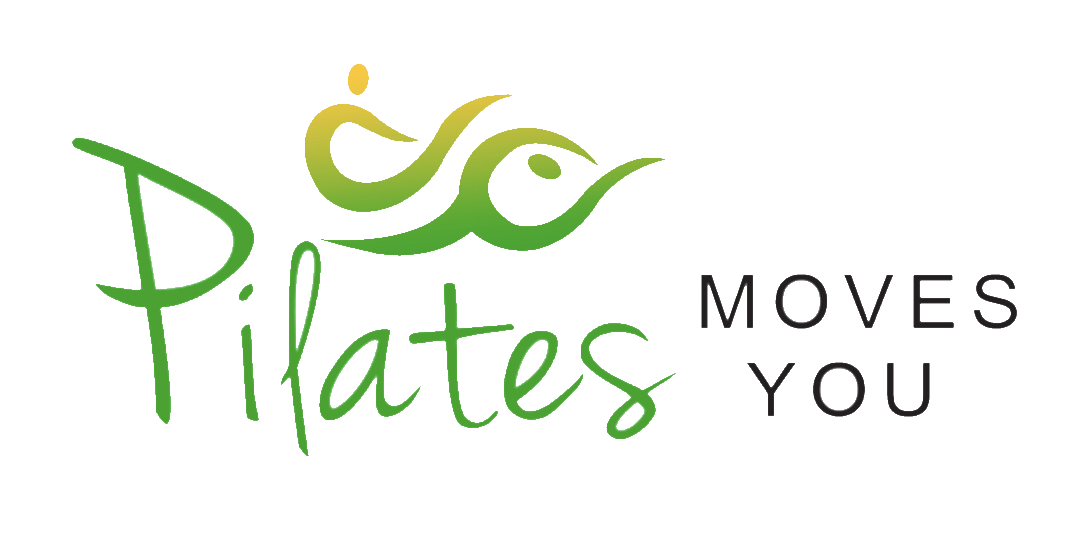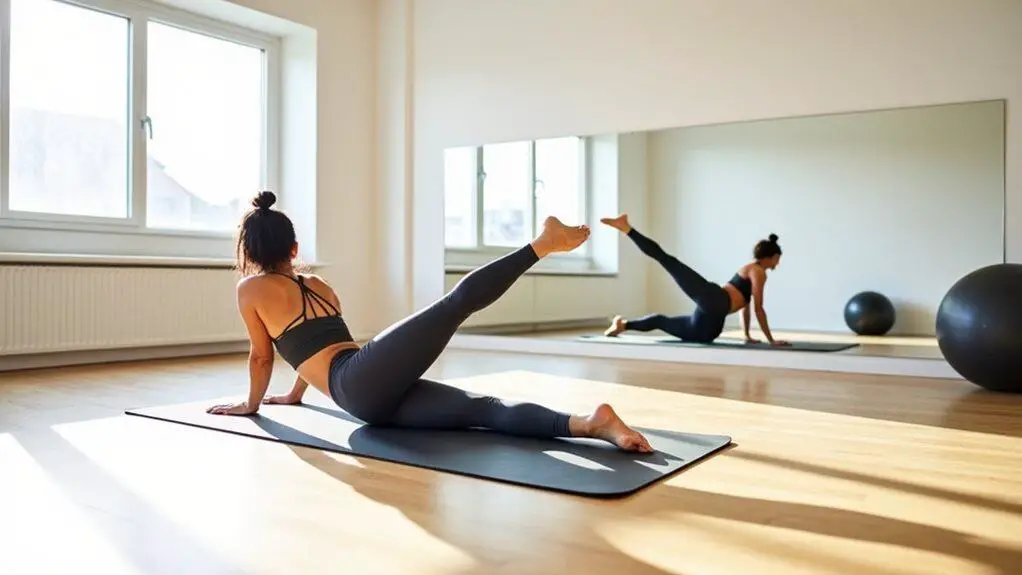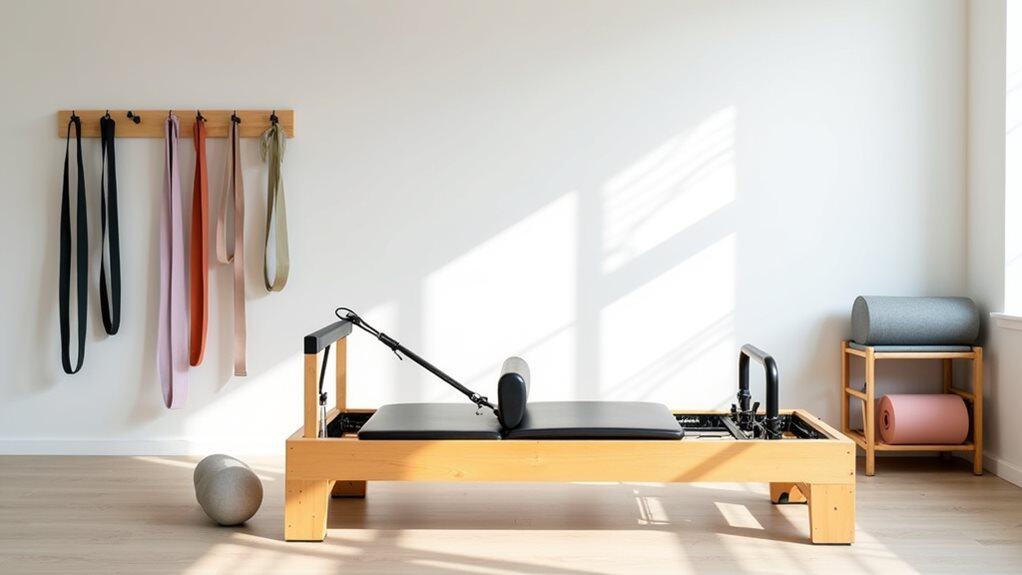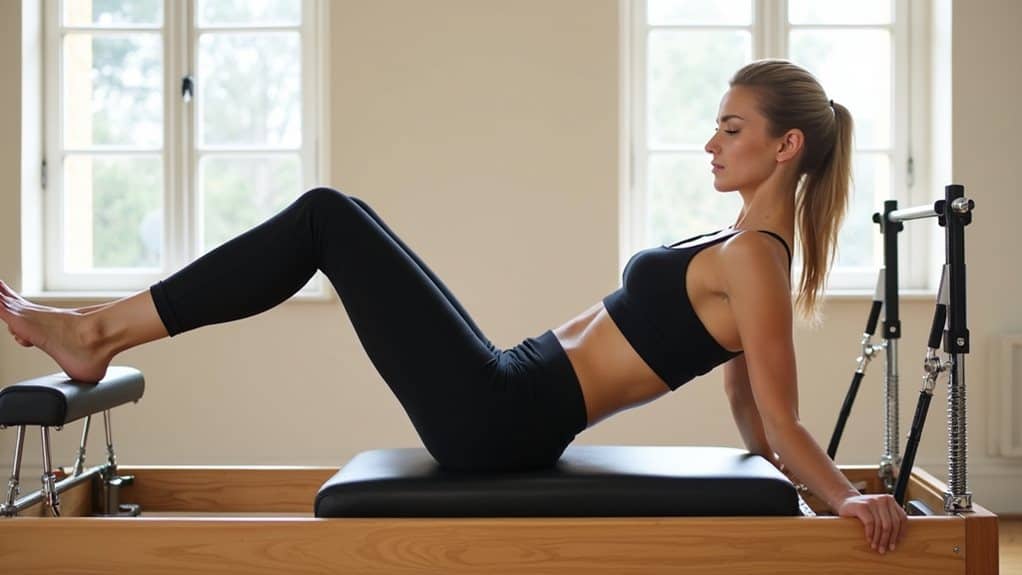To build effective digital Pilates sequences, you’ll need to structure progressive flows that translate clearly through screens. Start with foundational breath control and spinal articulation, then layer complexity through precise anatomical cues and multiple camera angles. Include equipment variations and three-tiered progression options for each exercise, while maintaining clear verbal direction and visual demonstrations. Account for digital lag by establishing systematic timing and checkpoints. This all-encompassing approach sets the foundation for mastering virtual instruction techniques.
Essential Components of Digital-Friendly Pilates Sequences
When designing digital Pilates sequences, five core components guarantee peak flow and client engagement: progressive warm-up, targeted muscle activation, balanced movement patterns, proper exercise shifts, and strategic cool-down phases.
You’ll need to structure your warm-up with breath control exercises that prepare both mind and body. Consider equipment variations to accommodate diverse client setups, whether they’re using reformers, mats, or resistance bands at home.
Begin with gentle spinal articulation before advancing to more complex movements. Ensure each shift maintains anatomical precision while building intensity gradually.
Your sequences should alternate between flexion and extension patterns, incorporating both bilateral and unilateral movements. Focus on clear, camera-friendly positions that translate well through digital platforms, allowing clients to maintain proper form throughout their practice.
Building Progressive Flows for Virtual Learning
Digital platforms require a specific approach to building progressive Pilates flows that maximize learning outcomes. When designing your sequences, structure movements from simple to complex, allowing clients to develop foundational control before advancing.
Effective virtual Pilates programming builds progressively, guiding students from basic foundations toward mastery through intentionally sequenced movement patterns.
Start with basic engagement techniques that translate clearly through screens, such as imprint-to-neutral spine progressions and scapular stabilization drills.
Incorporate feedback methods that work in virtual settings by using clear verbal cues and visual demonstrations. You’ll want to program three progression options for each exercise: regression for newer clients, standard variation, and advancement for experienced practitioners.
Consider camera angles and viewing limitations when selecting exercises, prioritizing movements that students can safely self-assess. Layer your cuing to address form, breath, and muscle activation patterns systematically throughout the sequence. Additionally, utilizing targeted messages tailored can enhance student engagement and improve learning outcomes in virtual environments.
Adapting Classical Sequences for Online Platforms
Traditional Pilates sequences require strategic modifications to maintain their integrity in virtual environments. When adapting classical sequences for online platforms, you’ll need to adjust your cuing to account for spatial limitations and camera angles.
Focus on precise anatomical references that translate clearly through screens. Consider breaking down complex movements into smaller components for better online engagement. You can modify classical adaptations by emphasizing visible landmarks like the anterior superior iliac spine and scapular positioning.
Position your camera to highlight these reference points during demonstrations. Implement progression checkpoints where clients can self-assess their form through specific alignment markers.
Create clear verbal cues that compensate for the lack of hands-on corrections, using directional language that guides students through each movement pattern with anatomical precision.
Visual Cuing Strategies for Remote Instruction
Effective visual cuing demands strategic camera positioning and clear anatomical landmarks for remote Pilates instruction.
When demonstrating exercises, you’ll need to show movements from multiple angles to help clients grasp proper form. Position your camera to highlight key anatomical reference points – particularly the spine’s neutral position, pelvic alignment, and scapular placement.
Incorporate visual demonstrations that emphasize muscular engagement techniques through clear, deliberate movements. You’ll want to zoom in on specific body segments when teaching complex exercises, helping clients identify precise alignment cues.
Use contrasting backgrounds to make your form more visible, and guarantee your workout space is well-lit from multiple angles. Break down each movement pattern into digestible segments, allowing clients to observe and replicate the proper biomechanical sequence.
Time Management and Pacing in Digital Sessions
Managing the flow of remote Pilates sessions requires precise timing strategies and adaptive pacing techniques. You’ll need to structure your session timing to account for digital lag and student response delays while maintaining ideal online engagement.
Break your digital class into precise segments: 5 minutes for initial alignment checks, 10 minutes for foundational warm-up sequences, 30 minutes for progressive movement patterns, and 5 minutes for cool-down integration.
Monitor your students’ breath patterns through video feeds to gauge their exertion levels and adjust your pacing accordingly. Track shifts between exercises using a digital timer, allowing 30-45 seconds for position changes and equipment adjustments.
You’ll maintain momentum by using clear, concise cues and anticipating common technical disruptions that might affect your session’s flow.
Frequently Asked Questions
How Do I Handle Technical Difficulties During Live-Streaming Pilates Classes?
You’ll need to check your audio issues before streaming, maintain backup equipment, monitor video quality constantly, and have a pre-written script ready. Keep your phone nearby for quick troubleshooting communication with clients.
What Is the Ideal Camera Angle for Demonstrating Pilates Exercises Online?
Studies show 89% of online fitness viewers prefer a 45-degree diagonal angle. Position your camera slightly elevated, 8-10 feet away, ensuring full-body visibility and clear demonstration of spinal alignment during exercises.
Should I Invest in Specific Software for Creating Digital Pilates Sequences?
You’ll benefit from dedicated sequence customization software to streamline your workflow and enhance client programming. Look for platforms offering exercise libraries, customizable templates, and progress tracking for peak teaching efficiency.
How Many Participants Should I Accept in Virtual Pilates Classes?
You’ll optimize participant engagement by limiting virtual class size to 8-12 students. This allows you to monitor form, provide individual cues, and maintain proper biomechanical alignment throughout each movement sequence.
What Backup Options Should Instructors Have if Internet Connection Fails?
You’ll need pre-recorded offline classes ready to share, alternative formats like PDF sequences, and backup mobile hotspot connectivity. Keep downloadable exercise progressions on multiple devices for immediate access during disruptions.
Final Thoughts
Like a master architect designing a blueprint, you’ve now acquired the tools to construct digital Pilates sequences that honor classical principles while embracing modern technology. By implementing precise visual cues, strategic progressions, and time-efficient flows, you’ll effectively guide your clients through neuromuscular integration and core stabilization patterns. Your virtual teaching methodology can now seamlessly bridge the gap between traditional mat work and contemporary digital instruction.



